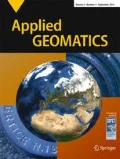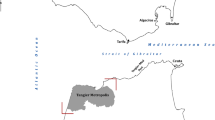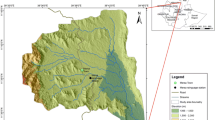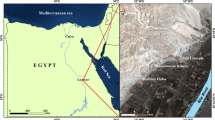Abstract
Soil loss has been long characterized as one of the main threats of climate change with possible impact to natural and cultural heritage (UNESCO report 2006). This study illustrates how applied geomatics integrating earth observation and geographical information systems (GIS) can be used to quantify this threat in an UNESCO protected archeological site as well as on cultural routes such as the ancient Hellenistic-Roman Road network. Both study sites are located in the western part of Cyprus, and specifically in Paphos district, which is an area with undergoing major pressure caused by soil erosion and soil loss. Multi-temporal earth observation methods were applied for identification, mapping and estimation of the possible soil loss caused by soil erosion in the period of the past 30 years. The soil loss was estimated using the Revised Universal Soil Loss Equation (RUSLE) model. Special attention was given to the land use/land cover factor (C) and its impact on the overall estimation of the soil loss. Cover factor represents the effect of soil-disturbing activities, plants, crop sequence and productivity level, soil cover, and subsurface bio-mass on soil erosion. Urban areas have a definite role in retarding the recharge process, leading to increased runoff and soil loss in the broader area. On the other hand, natural vegetation plays a predominant role in reducing water erosion. In specific, cover factor was estimated for the cultural routes, classified and observed in years 1987 and 2016 in the District of Paphos. The variance of the values between 2 years was then calculated in order to identify the areas under major pressure of soil erosion caused by the changes in land use and land cover. In addition, high-resolution optical data were analyzed in order estimate the multi-temporal changes in soil loss in the archeological site of Nea Paphos. The results shows that integrated earth observation and GIS can be used as a systematic tool for monitoring cultural heritage sites against natural threats such as soil loss.











Similar content being viewed by others
References
Achilli V, Carrubba P, Fabris M, Menin A, Pavanello P (2015) An archival geomatics approach in the study of a landslide. Appl Geomat 7:263. https://doi.org/10.1007/s12518-015-0153-4
Agapiou Α, Lysandrou V (2015) Remote sensing archaeology: tracking and mapping evolution in European scientific literature from 1999 to 2015. J Archaeol Sci Rep 4:192–200
Agapiou A, Alexakis DD, Lysandrou V, Sarris A, Cuca B, Themistocleous K, Hadjimitsis DG (2015) Impact of urban sprawl to archaeological research: the case study of Paphos area in Cyprus. J Cult Herit 16(5):671–680. https://doi.org/10.1016/j.culher.2014.12.006.
Agapiou A, Lysandrou V, Hadjimitsis DG (2017) Optical remote sensing potentials for looting detection. Geosciences 7(4):98. https://doi.org/10.3390/geosciences7040098
Alexakis D, Hadjimitsis D, Agapiou A (2013a) Integrated use of remote sensing, GIS and precipitation data for the assessment of soil erosion rate in the catchment area of “Yialias” in Cyprus. Atmos Res 131:108–124. https://doi.org/10.1016/j.atmosres.2013.02.013
Alexakis DD, Agapiou A, Themistocleous K, Lysandrou V, Sarris A, Hadjimitsis DG (2013b) Natural and human risk assessment of the archaeological sites of Paphos area (Cyprus) with the use of remote sensing and GIS, Bulletin of the geological Society of Greece, vol. XLVII 2013, Proceedings of the 13th International Congress, Chania
Bekker-Nielsen T (2004) The roads of ancient Cyprus, Museum Tusculanum Press, ISBN 8772899565, 9788772899565
Colette A (2006) Climate Change and World Heritage Report on predicting and managing the impacts of climate change on World Heritage and Strategy to assist States Parties to implement appropriate management responses, World Heritage reports 22, Publication based on Document WHC-06/30.COM/7.1 presented to the World Heritage Committee at its 30th session, Vilnius, Lithuania, 8-16 July 2006 Published in May 2007 by UNESCO World Heritage Centrehere is the link https://www.google.com/urls?/a=t&rct=j&q=&esrc=s&source=web&cd=2&ved=2ahUKEwi2juKz5KXdAhWFl4sKHfs8CUkQFjABegQICRAC&url=https%3A%2F%2Fwhc.unesco.org%2Fdocument%2F8874&usg=AOvVaw0nReIr3JxlU3Sr9VkGIvZS
Chen H, Oguchi T, Wu P (2017) Assessment for soil loss by using a scheme of alterative sub-models based on the RUSLE in a Karst Basin of Southwest China. J Integr Agric 16(2):377–388. https://doi.org/10.1016/S2095-3119(16)61507-1
Chimidi G, Raghuvanshi TK, Suryabhagavan KV (2017) Landslide hazard evaluation and zonation in and around Gimbi town, western Ethiopia—a GIS-based statistical approach. Appl Geomat 9:219–236. https://doi.org/10.1007/s12518-017-0195-x
Cuca B, Agapiou A (2017) Impact of land use change to the soil erosion estimation for clutural landscapes: case study of Paphos District in Cyprus. Int Arch Photogramm Remote Sens Spatial Inf Sci XLII-5/W1:25–29. https://doi.org/10.5194/isprs-archives-XLII-5-W1-25-2017
Cuca B, Tzouvaras M, Agapiou A, Lysandrou V, Themistocleous K, Nisantzi A, Hadjimitsis DG (2016) Earth observation technologies in service to the cultural landscape of Cyprus: risk identification and assessment, Proceedings of RSCy2016, SPIE - The International Society for Optical Engineering, 9688, art no. 96880Y. https://doi.org/10.1117/12.2241669
Del Frate F, Fabrini I, Fiumi L et al (2015) Analysis of the soil sealing in the urban area of Rome through automatic processing of satellite data with neural networks. Appl Geomat 7:283–292. https://doi.org/10.1007/s12518-015-0157-0
Department of Antiquities (2017) Nea Paphos (by Ministry of Transport, Communications and Works of the Republic of Cyprus), last accessed in April 2017 via http://www.mcw.gov.cy/mcw/da/da.nsf/DMLindex_en/DMLindex_en
Fernández C, Vega AJ (2018) Evaluation of the rusle and disturbed wepp erosion models for predicting soil loss in the first year after wildfire in NW Spain. Environ Res 165:279–285. https://doi.org/10.1016/j.envres.2018.04.008
Giardino JM (2011) A history of NASA remote sensing contributions to archaeology. J Archaeol Sci 38:2003–2009
Hadeel AS, Jabbar MT, Chen X (2010) Application of remote sensing and GIS in the study of environmental sensitivity to desertification: a case study in Basrah Province, southern part of Iraq. Appl Geomat 2:101–112. https://doi.org/10.1007/s12518-010-0024-y
Hammer E, Seifried R, Franklin K, Lauricella A (2018) Remote assessments of the archaeological heritage situation in Afghanistan. J Cult Herit. https://doi.org/10.1016/j.culher.2017.12.008
Howland DM, Jones WNI, Najjar M, Levy ET (2018) Quantifying the effects of erosion on archaeological sites with low-altitude aerial photography, structure from motion, and GIS: a case study from southern Jordan. J Archaeol Sci 90:62–70. https://doi.org/10.1016/j.jas.2017.12.008
Kayet N, Pathak K, Chakrabarty A, Sahoo S (2018) Evaluation of soil loss estimation using the RUSLE model and SCS-CN method in hillslope mining areas. Int Soil Water Conserv Res 6(1):31–42. https://doi.org/10.1016/j.iswcr.2017.11.002
Kincey M, Gerrard C, Warburton J (2017) Quantifying erosion of ‘at risk’ archaeological sites using repeat terrestrial laser scanning. J Archaeol Sci Rep 12:405–424. https://doi.org/10.1016/j.jasrep.2017.02.003
Lasaponara R, Masini N (2011) Satellite remote sensing in archaeology: past, present and future perspectives. J Archaeol Sci 38:1995–2002
Lasaponara R, Leucci G, Masini N, Persico R (2014) Investigating archaeological looting using satellite images and GEORADAR: the experience in Lambayeque in North Peru. J Archaeol Sci 42:216–230. https://doi.org/10.1016/j.jas.2013.10.032
Li J, Roy DP (2017) A global analysis of sentinel-2A, sentinel-2B and Landsat-8 data revisit intervals and implications for terrestrial monitoring. Remote Sens 9:902
Moore ID, Burch FJ (1986) Physical basic of the length–slope factor in the universal soil loss equation. Soil Sci Soc Am J 50:1294–1298
Panagos P, Meusburger K, Ballabio C, Borrelli P, Alewell C (2014) Soil erodibility in Europe: a high-resolution dataset based on LUCAS. Sci Total Environ 479–480:189–200. https://doi.org/10.1016/j.scitotenv.2014.02.010
Panagos P, Borrelli P, Poesen J, Ballabio C, Lugato E, Meusburger K, Montanarella L, Alewell C (2015) The new assessment of soil loss by water erosion in Europe. Environ Sci Pol 54:438–447. https://doi.org/10.1016/j.envsci.2015.08.012
Pastonchi L, Barra A, Monserrat O, Luzi G, Solari L, Tofani V (2018) Satellite data to improve the knowledge of geohazards in world heritage sites. Remote Sens 10:992
Renard KG, Foster GR, Weesies GA, McCool DK, Yoder DC (1997) Predicting soil erosion by water: a guide to conservationplanning with the Revised Universal Soil Loss Equation (RUSLE). Agriculture Handbook No. 703, USDA-ARS
Tang P, Chen F, Zhu X, Zhou W (2016) Monitoring cultural heritage sites with advanced multi-temporal InSAR technique: the case study of the summer palace. Remote Sens 8:432
Tanyaş H, Kolat C, Süzen LM (2015) A new approach to estimate cover-management factor of RUSLE and validation of RUSLE model in the watershed of Kartalkaya Dam. J Hydrol 528:584–598. https://doi.org/10.1016/j.jhydrol.2015.06.048
Tapete D, Cigna F, Donoghue NMD (2016) ‘Looting marks’ in space-borne SAR imagery: measuring rates of archaeological looting in Apamea (Syria) with TerraSAR-X staring spotlight. Remote Sens Environ 178:42–58. https://doi.org/10.1016/j.rse.2016.02.055
Teng H, Liang Z, Chen S, Liu Y, Viscarra Rossel AR, Chappell A, Yu W, Shi Z (2018) Current and future assessments of soil erosion by water on the Tibetan Plateau based on RUSLE and CMIP5 climate models. Sci Total Environ 635:673–686. https://doi.org/10.1016/j.scitotenv.2018.04.146
Winning KH, Hann JM (2014) Modelling soil erosion risk for pipelines using remote sensed data, Biosystems Engineering 127:135–143 https://doi.org/10.1016/j.biosystemseng.2014.08.020
Funding
The results of these research activities have been partially funded within the project CLIMA (Cultural Landscape risk Identification, Management and Assessment), in the framework of Joint Programming Initiative for Cultural Heritage (JPI CH), agreement number KOINA/ΠΚΠ-HERITAGE PLUS/0314/07.
Author information
Authors and Affiliations
Corresponding author
Rights and permissions
About this article
Cite this article
Cuca, B., Agapiou, A. Impact of land-use change and soil erosion on cultural landscapes: the case of cultural paths and sites in Paphos district, Cyprus. Appl Geomat 10, 515–527 (2018). https://doi.org/10.1007/s12518-018-0237-z
Received:
Accepted:
Published:
Issue Date:
DOI: https://doi.org/10.1007/s12518-018-0237-z




